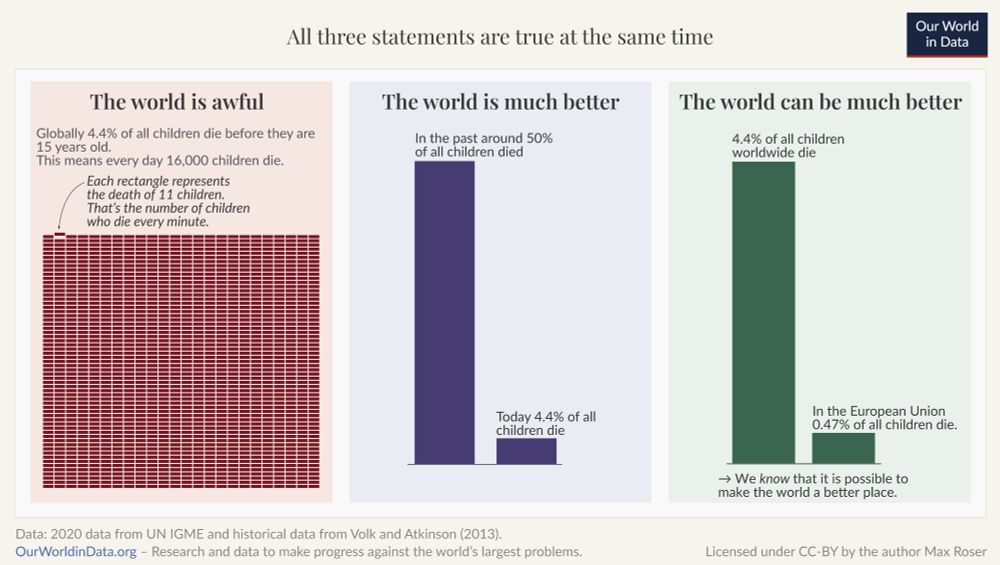

All three statements are true at the same time. Understanding this is key to solving big global problems.
We believe data & research can help us understand both the problems we face & the progress that’s possible. 🧵
In the spring and fall each year, the International Monetary Fund (IMF) publishes its World Economic Outlook. The latest report was published this past October.

In the spring and fall each year, the International Monetary Fund (IMF) publishes its World Economic Outlook. The latest report was published this past October.
(This Data Insight was written by @eortizospina.bsky.social.)
Seasonal influenza is sometimes seen as a mild illness, but it remains a major cause of death.

(This Data Insight was written by @eortizospina.bsky.social.)
Seasonal influenza is sometimes seen as a mild illness, but it remains a major cause of death.

Measuring happiness is difficult, but one way to understand how satisfied people are with their lives is to simply ask them.

Measuring happiness is difficult, but one way to understand how satisfied people are with their lives is to simply ask them.
We’ve updated 17 of our charts using the latest release.

We’ve updated 17 of our charts using the latest release.

Among others, this includes: physical integrity rights, such as not being killed or tortured;...

Among others, this includes: physical integrity rights, such as not being killed or tortured;...
It’s great to see publications using this feature! Here are recent examples, from earth.org and the German magazine, Stern.

It’s great to see publications using this feature! Here are recent examples, from earth.org and the German magazine, Stern.



Check out the 3 podcast episodes featuring Hannah:
1/ Saving the World From Bad Ideas with Mark Lynas

Check out the 3 podcast episodes featuring Hannah:
1/ Saving the World From Bad Ideas with Mark Lynas

Help shape global insights into how technologies evolve.
Link in thread ⬇️

The wipeout of the largest mammals is a global phenomenon that we see across many regions.

The wipeout of the largest mammals is a global phenomenon that we see across many regions.

Just click the “Share” icon in the bottom right of any chart and select “Copy chart as image”. No need to take a screenshot.

Just click the “Share” icon in the bottom right of any chart and select “Copy chart as image”. No need to take a screenshot.
Long-term surveys in the United States suggest that around one-third of people experience an anxiety disorder at some point in their lives.

Long-term surveys in the United States suggest that around one-third of people experience an anxiety disorder at some point in their lives.
→ ourworldindata.org/search
With such a rich publication—nearly 14,000 charts and 100s of articles on 120+ topics—it can be hard to find what matters to you.
Now, finding what you’re looking for, or discovering something new, has never been easier.

→ ourworldindata.org/search
With such a rich publication—nearly 14,000 charts and 100s of articles on 120+ topics—it can be hard to find what matters to you.
Now, finding what you’re looking for, or discovering something new, has never been easier.

→ ourworldindata.org/search
With such a rich publication—nearly 14,000 charts and 100s of articles on 120+ topics—it can be hard to find what matters to you.
Now, finding what you’re looking for, or discovering something new, has never been easier.

→ ourworldindata.org/search
With such a rich publication—nearly 14,000 charts and 100s of articles on 120+ topics—it can be hard to find what matters to you.
Now, finding what you’re looking for, or discovering something new, has never been easier.

How many people do you know by name?
One study found that the average American knows 611.
In a world of 8 billion, that’s less than 0.00001%. A 100,000th of a percent.
We can’t see much of the world through our direct experience

How many people do you know by name?
One study found that the average American knows 611.
In a world of 8 billion, that’s less than 0.00001%. A 100,000th of a percent.
We can’t see much of the world through our direct experience
The scientific evidence is clear that this is incorrect.

The scientific evidence is clear that this is incorrect.

